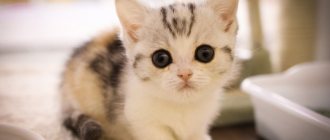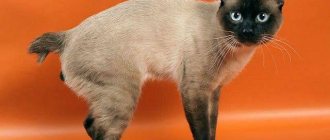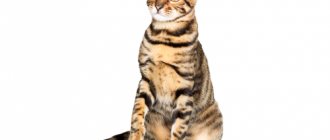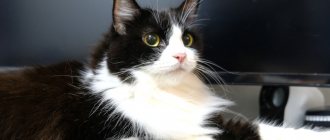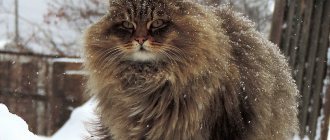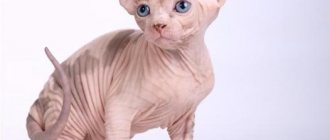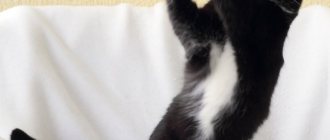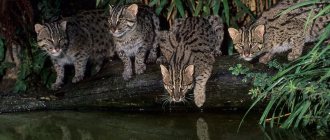Cats with short legs are often the subject of social media posts because of their cute appearance. Their body is of standard size, and their limbs are 2–3 times shorter than those of ordinary cats.
The most famous representative of this group is, of course, the munchkin. A distinctive feature of these animals is the ability to stand on their hind legs for a long time: the cat crouches, rests its tail and can remain in this position for quite a long time.
Breeds of kittens with short legs are quite expensive because they are rare.
Origin story
Until the end of the 80s. Most experts believed that the short-legged animal was inferior and unhealthy. The Munchkin, as an independent variety, began to develop in 1983.
In Louisiana, Sandra Hochenedel picked up a street cat with abnormally short legs. The woman believed that this feature was related to her lifestyle: she ate poorly and could not develop normally.
However, the cat gave birth to kittens with the same short legs. The owner was very surprised and gave one female from the litter to her friend. After a while, she also gave birth to short-legged babies. Sandra thought about this amazing phenomenon and turned to a veterinarian.
Studies were carried out, after which the veterinarian concluded that the peculiarity of the structure of the animal’s legs was due to a mutation in the genetic code. It was found that this is not a defect and does not affect health.
The description of the Munchkin breed was compiled two years after the appearance of the first offspring. Many breeders continued to consider the animals inferior and ugly. However, in 1995 they began to be presented at exhibitions.
Munchkin fold
Representatives of this breed differ in ear set from the existing standard, but cannot be recognized as a separate species. This is due to the presence of a risk of gene mutation and, as a result, health problems.
The Fold Munchkin or, as breeders call it, Folmax, is similar in appearance to the Scottish Fold cat due to genetic abnormalities in the skeleton and ear structure.
Interesting! The long-haired, fluffy Munchkin with very short legs, despite genetic abnormalities, has become popular among experienced breeders seeking to obtain a variety of options when crossing this species with other individuals of the family.
Distinctive features
The breed appeared relatively recently, so its standard has not yet been fully formed. However, the basic characteristics are already there:
| Sign | Description |
| Head | Wide, with smooth outlines, wedge-shaped. Proportional to the body. In adult males it is more developed than in females. |
| Nose | Average, slight bend allowed. |
| Ears | Located high. Fluffy, wide at the base, rounded at the tips. |
| Eyes | They have the shape of a walnut. Located widely, at a slight angle to the ears. The shade depends on the color of the coat. |
| Neck | Thickened and muscular, of medium length. |
| Torso | Medium size. |
| Paws | The hind ones are slightly longer than the front ones. It is permissible to bend the latter towards the inside. Limbs are straight. |
| Backbone | Not heavy, but not lightweight. |
| Muscles | Well developed. |
| Tail | Equal to the length of the body. Stands upright when moving. |
| Weight | In males - 3-4 kg. In females - 2-3.6 kg. |
| Wool | Short: shiny, plush to the touch. Long: dense and silky with a lordly collar. |
| Coloring | Any colors and combinations. |
Breeds of short-legged cats
Having achieved public recognition of short-legged cats, breeders did not stop there. They continue to experiment, creating new breeds of miniature pets.
Table: physiological characteristics characteristic of representatives of short-legged breeds
| Options | Dimensions |
| Height at withers | 15–25 cm |
| Leg length | 1/3 of the height at the withers |
| Weight |
|
Munchkin
Munchkins are the ancestors of all short-legged cat breeds. These pets are called “dachshund cats.” The similarity is due to physiological characteristics - miniature stature, elongated body and short legs.
Curious little munchkins love to control everything that happens around them. To do this, they stretch out in a column, taking a meerkat pose. Cats can stay in this position for hours, looking out the window or watching the household.
Munchkins are actively used in breeding as carriers of the gene for short legs
These big-eyed and cute “buttons,” despite their short limbs, are very active and mobile animals. They have a calm and balanced character. Cats are quite social and easily make contact with all family members and animals living in the same territory. Little ones love affection and willingly give mutual love and tenderness to their owner.
Photo gallery: Munchkin cats
The Munchkin Lilliputian is listed in the Guinness Book of World Records as the shortest animal in the world Munchkin kittens look very much like a small plush toy Curious munchkins can stand on their hind legs for hours in the meerkat pose
Video: Munchkin cat
Minskin
The Minskin is a cross between the Munchkin and the Canadian Sphynx. Later, two more breeds were added to breeding - the Devon Rex and the Burmese. Minskins have fur on the tips of their paws and ears, which is why they are nicknamed hobbits.
Minskins are very miniature animals, weighing no more than 3 kg
Pets have a calm and friendly character. They are very sociable and easily get close to all household members and animals living in the neighborhood. Minskins are very attached to one owner and literally follow on his heels. They get very sad when they are apart, so they should not be left alone for a long time.
Photo gallery: Minskin cats
Minskin cats have a delicate skin that feels like cashmere.
Kittens have a very mischievous and spontaneous character, but with age they become more sedate
The furry points growing on the tips of the paws and ears gave munchkins their second name - hobbits.
Video: Minskin - all about the breed
Bambino
Bambino cats are a cross between a Munchkin and a Sphynx, just like the Minskin, so these breeds are often confused and the Minskin is sometimes considered a variant of the Bambino. Minskins are distinguished by the presence of hair on the head, ears, paws and tail. Representatives of the bambino breed are carriers of two special genes at once - short legs and hairlessness. The name "bambino" is translated from Italian as "child". And this is true - amazing animals remain children even in old age.
Bambinos love to sit on their hind legs, stretched out like a kangaroo.
Cute little ones have a sociable character and easily join any team. They get along well with all family members, but for themselves they choose a leader to whom they remain devoted until the end of their lives. Absolutely non-aggressive bambinos get along well with all pets living in the neighborhood. Cats make excellent companions for people who are willing to devote enough time to them.
Photo gallery: Bambino cats
The velor skin of a bambino can be of any color, but solid colors are most valued. The ears of bambino cats are decorated with small tassels
The graceful bambino looks like an ivory figurine
Video: Bambino cat breed
Napoleon (minuet)
The Napoleon breed was created by crossing munchkins with long-haired Persians. At first the cat was named in honor of the great commander Napoleon Bonaparte, but in 2015 the breed was given another name - Minuet. Cute babies inherited their miniature size from the Munchkins, and from the Persians - a luxurious fur coat with thick pile, large round eyes and a slightly flattened muzzle.
Napoleon owners claim that pets not only help relieve stress, but can also relieve pain
Napoleons are very gentle and affectionate pets, ready to stay with their owner all day long. Their sociability and friendliness have no boundaries. Cats are extremely attached to one owner, but treat all family members with respect. These cats absolutely do not know how to show aggression, so the breed is ideal for families with small children.
Photo gallery: Napoleon cat
Long-haired specimens of the Persian type require more frequent combing and removal of tangles. The hair of Napoleons can be long and silky, or it can be short and plush, like exotics.
The Napoleon kitten is incredibly attached to people and is in dire need of constant love and care.
Video: Napoleon cat
Dwelf
The closest relatives of Dwelfs are Canadian Sphynxes, Munchkins and American Curls. As a result of selection, offspring were obtained with short legs, a hairless body and ears bent back.
Dwelfs inherited from their relatives their miniature size, hairless body and backward-curved ears.
Despite their unusual appearance, Dwelfs are no different from their relatives. These cats are inquisitive, smart and affectionate. They choose one owner and sincerely become attached to him. Dwelfs get along well not only with all family members, but also with animals. Small pets are very vulnerable and touchy, so you need to communicate with them very carefully.
Photo gallery: Dwelf cats
Dwelf kittens have small folds on their bodies, which disappear with age. The weight of an adult Dwelf practically does not exceed 2 kg.
Dwelfs have an exotic appearance
Video: Dwelf breed
Kinkaloe
The Kinkalow is a cross between the Munchkin and the American Curl. This is a young and rare breed, which numbers no more than a dozen specimens.
Kinkaloos are born with straight ears, which bend 90-180° a couple of weeks after birth.
Kinkalow wool has an extraordinary shine and silkiness.
Pets are distinguished not only by their special appearance, but also by their balanced character. Cats easily fit into any group, love social games and are quite peaceful with other animals. They choose one owner, whom they sincerely love and yearn for separation from him. Kinkalows are ideal companions that rightfully become favorites of the whole family.
Photo gallery: Kinkalow cats
Kittens' ears begin to curl two weeks after birth and are fully formed by 5 months.
Kinkalow cats can be of any color, and the color of their eyes directly depends on the color of their coat. Kinkalows inherited the signature meerkat pose from the Munchkin.
Video: miniature kinkalow cats
Skookum
The Skookum breed was created by crossing the Short-legged Munchkin and the Curly-haired La Perma. Translated from the Indian dialect, “skukum” means “brave”, “unbending”.
Pets can be short-haired or long-haired, and the longer the hair, the more curly it is.
Skookum cats inherited short limbs from Munchkins and curly hair from La Perms.
Skookums have inherited the munchkin's personality. They are incredibly inquisitive and active. Kids can spend hours playing with everything that rolls and rustles. Skookums are very friendly towards all family members, without focusing on one owner. Due to their friendly nature, pets get along well with small children and animals. Skookums are silent cats; they practically never meow.
Photo gallery: Skookum cats
Kittens are sometimes born with different colored eyes. The shorter the skookum's coat, the less curl it has.
The Skookum breed is one of the experimental ones, so purchasing kittens is quite difficult and expensive.
Video: Skookum cats
Lambkin
Lambkins (translated from English as lambs) were the result of mating a Muncchin and a Selkirk Rex. Cats look like miniature, short-legged sheep. Features of lambkins are unusual sapphire-colored eyes, strong, short limbs and curly fur. There are so few representatives of this breed that they can literally be counted on one hand.
The Lambkin breed is distinguished by short, dense limbs, curly hair and sky blue eyes.
Lambkins are very inquisitive, cheerful and restless animals. These pets love all family members without exception, but are especially attached to children. Cats are never bored and can keep themselves busy in the absence of their owners. Lambkins are loyal to all animals.
Gallery: lambkin cats
Lambkin cats look like a miniature, short-legged sheep. The Lambkin's mischievous face is decorated with curly whiskers
The little lambkin's curls resemble a perm
Video: lambkin breed
Nutrition
The number of meals depends on the age of the pet:
- up to four weeks - five times a day;
- from twelve weeks to one year - three or four times;
- adults - twice.
Up to four months it is necessary to give porridge, meat, and fermented milk products. The diet of adults includes vegetables and fish fillets.
Premium dry and wet food and holistic foods are recommended.
Required products on the menu:
- unsweetened fermented milk products without dyes and synthetic thickeners;
- dietary meat;
- sea fish;
- cereals, excluding legumes;
- vegetables, except potatoes;
- chicken and quail yolks;
- meat by-products (for example, liver).
Fish and meat should be boiled and mixed into porridge. Vegetables are not fully digestible by animals. This must be taken into account when creating a menu.
General information
Munchkins are small animals. Males are larger than females. The weight of an adult cat reaches 3.5 kg. The average weight of a female in adulthood reaches 2.5 kg.
- The most common colors of longhaired munchkins are bicolor, smoke and silver.
- Among the shorthairs, individuals with Siamese, Minky, Celia, and Colorpoint colors predominate.
Hygiene
Munchkins come in long-haired and short-haired varieties. Pets should be combed with a slicker brush, comb, or brush. The movement is from head to tail. Done once a week.
Wash cats if necessary. A special shampoo is used, selected according to the type of coat and skin. After bathing, the pet is dried with a soft cloth or dried with a hairdryer.
Munchkin's eyes are treated with a cotton pad soaked in boiled water or tea. Teeth are brushed every two weeks with cat toothpaste. Wax and accumulations of dirt from the ears are removed with cotton swabs with a special solution or drops, Vaseline. The claws are trimmed as they grow with a nail clipper.
Health
Munchkins are hardy and healthy. They have a strong immune system and no predisposition to severe genetic pathologies.
A hereditary disease to which the breed is susceptible is lordosis of the spine in the form of its stretching in the thoracic region.
The pathological condition provokes problems with the heart and lungs. Most often, the disease manifests itself in obesity or genetic characteristics. Therefore, it is important to monitor your pet’s diet and carefully choose a partner when mating.
Breed faults:
- convex chest;
- too round head and eyes;
- absence of tail, fingers, polydactyly;
- snub or elongated nose;
- “cow set”;
- short, very stocky body;
- curly hair;
- concave back, drooping croup;
- absence of testes;
- blindness and strabismus.
Also, a cat will be disqualified at an exhibition if it has a difficult character, cowardice, or aggressiveness.
Character
Feedback on the behavior of munchkin cats is always positive. This is a very affectionate, sociable, peaceful and unforgiving pet. He is active and cheerful, he can cheer you up and play with your children. But don’t think that this cat won’t be able to fend for itself.
Pets love to create their own “treasuries.” Therefore, if you cannot find something, then most likely this thing is in the cat’s hiding place.
These animals are good for walking on a leash, as they get along well with others (people and animals). They are distinguished by neatness and cleanliness.
These animals are also very intelligent and will quickly understand what can and cannot be done.
Interesting fact: a feature of the breed is the almost complete absence of meowing. This would be an ideal option for those who don't like their pets making loud noises.
Advantages and disadvantages
The breed has many more positive aspects than negative aspects:
| Advantages | Flaws |
| Obedient, good-natured, smart. | They have a habit of hiding things. |
| They calmly accept changes and new surroundings. | They don't catch rodents. |
| They rarely get sick. | You should not be allowed out for walks unattended. |
| They don’t jump on tables or cabinets, so they don’t hit fragile things or steal food. | If you don't hide the toys, they wake you up at night. |
| Do not require special care. | |
| Not picky eaters. | |
| Do not spoil indoor flowers. | |
| They are good with children and other pets. | |
| Not intrusive. | |
| Not aggressive. | |
| They rarely meow. |
Owner reviews
This breed appeared with us quite recently, so it does not have many reviews. We can safely say that the breed is new on our territory, so people still do not have enough knowledge about this breed of cats. In this case, it is recommended to purchase kittens from trusted nurseries. Owners point out the fact that short-haired representatives of the Munchkin breed are much easier to care for, while long-haired pets need to be brushed regularly and bathed more often.
Interesting moment! If there is a high-quality scratching post in the house, then the pet can independently cope with the process of growing claws, otherwise the owner will have to trim the pet’s claws themselves at least once a month. Feeding the animal is possible both on the basis of purchased dry, but high-quality food, and on the basis of natural food products.
Due to the fact that the breed has a tendency to overeat with subsequent obesity, it is very important to follow a feeding regime. Although this breed is considered to be quite resistant to various ailments, lordosis is a very common problem in munchkins. If there is a slight deviation associated with the curvature of the spine, excess weight of the animal can aggravate this problem by increasing the load on the heart muscle. In the case of normal weight and absence of injuries, such deviations do not affect the health of the animal in any way. The breed does not require special care, and its friendly disposition and agility are making it increasingly popular.
Price
When deciding to buy a kitten, you need to pay attention to the following:
- age of parents;
- number of matings between father and mother;
- diseases of parents, hereditary pathologies;
- features of pregnancy and childbirth;
- absence of individuals with extra toes in the litter;
- availability of certificates of vaccinations and deworming in accordance with age;
- sterilization and castration;
- behavioral characteristics of the kitten and its parents;
- food given to the animal;
- content rules.
A kitten without documents costs between 15-25 thousand rubles.
Purebred individuals - 40-60 thousand rubles. The price of animals in high-level nurseries is determined by experts. Lilieput – Shortest Cat Guinness World Records 2014 Photo Credit: James Ellerker/Guinness World Records
1111
Kitten in the house
In order for a munchkin kitten to appear in a family, you need to think about where you can buy a pet. When choosing a place of purchase, you should pay attention to nurseries and what breeders of this breed will offer, since Munchkin kittens in such places of sale will already be litter box trained and with the necessary vaccinations.
If you are not satisfied with the prices of breeders or kennels, you can use other places, such as exhibitions or online advertisements, but remember that there is a risk of buying a false munchkin.
A munchkin costs from 3 to 20 thousand rubles. The cost mainly depends on the color and age of the individual.
Summarizing all of the above, we point out that when the choice of pets is made, it must be conscious and made with maximum responsibility.
